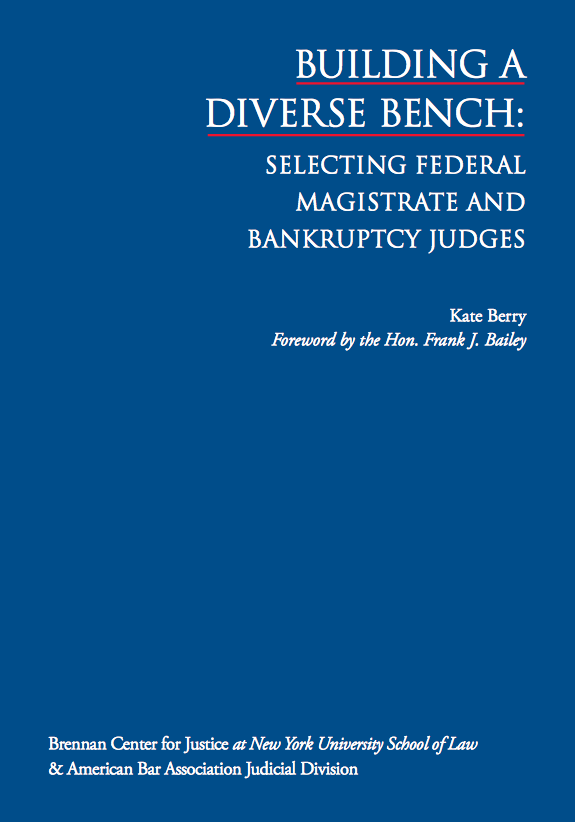Seven Recommendations for Building a Diverse Bench
 This month, the Brennan Center for Justice at NYU School of Law and the American Bar Association Judicial Division released Building a Diverse Bench: Selecting Federal Magistrate and Bankruptcy Judges, a resource that offers practical steps the federal judiciary can take to promote a more diverse bench.
This month, the Brennan Center for Justice at NYU School of Law and the American Bar Association Judicial Division released Building a Diverse Bench: Selecting Federal Magistrate and Bankruptcy Judges, a resource that offers practical steps the federal judiciary can take to promote a more diverse bench.
A diverse bench is essential to an effective judiciary. A bench that reflects the diversity of the public it serves enhances public confidence in the role of the courts in our democracy, and provides role models for groups underrepresented in the legal profession. And diversity is more than symbolic—having broader perspectives on the bench produces a richer jurisprudence, incorporating a wider and more representative range of experiences, backgrounds, and perspectives.
Federal courts today fail to reflect the diversity of the public they serve, and magistrate and bankruptcy benches are particularly unrepresentative. Women comprise over half of the U.S. population, yet hold only a third of magistrate and bankruptcy judgeships. People of color comprise almost 40 percent of the U.S. population, but hold only 15 percent of magistrate judgeships and 7 percent of bankruptcy judgeships. While federal district and circuit court judgeships are similarly unrepresentative for women, people of color hold nearly 25 percent of such judgeships: federal and district circuit court benches are markedly more representative for people of color than are bankruptcy and magistrate benches.
These disparities are particularly troubling because most Americans who encounter federal courts appear before magistrate or bankruptcy judges. Magistrates handle criminal and civil cases, from setting bail to hearing motions, and can rule on federal civil cases if the parties consent. Meanwhile, nearly all bankruptcy cases come before a federal bankruptcy judge at some stage. There are more active magistrate and bankruptcy judges (925) than active district and circuit court judges combined (795).
Building a Diverse Bench details concrete steps that federal courts—whose judges are responsible for appointing magistrate and bankruptcy judges—can take to increase diversity among magistrate and bankruptcy benches:
- Diversify the Applicant Pool:
- Engage in "Pipeline Building": Conduct outreach to law students and other potential applicants for judicial vacancies, with information about the application process and the duties of magistrate and bankruptcy judges, to encourage consideration of a career on the bench. Speak to affinity and community groups about the importance of merit selection panels, to encourage applications.
- Proactively Recruit Diverse Candidates: Begin the recruitment process early, and develop strategies to recruit diverse candidates. For instance, reach out to minority and affinity bar associations to recruit strong candidates, or host "office hours" to allow potential applicants to discuss the process with court officials.
- Tailor the Job Description and Distribution Strategy: Having a transparent application process and widely disseminating relevant application information can increase the number of diverse applicants. Therefore, write and distribute a detailed vacancy description, particularly to stakeholders like minority and women’s bar associations.
- Diversify the Selection Panel: Diverse merit selection panels are integral to diversifying the bench. Therefore, seek recommendations for merit selection panelists from stakeholders like minority bar associations. Courts can also increase the panel’s size to include more varied perspectives.
- Prioritize Diversity Throughout Vetting and Selection Stages:
- Establish Rules for the Vetting Process, Affirm Diversity as a Goal: The panel should establish clear rules for each stage of the vetting and selection process, to ensure candidates are treated fairly. Panelists should also receive implicit bias training, which data shows effectively mitigates unconscious biases.
- Standardize the Interview Process: Individuals are particularly vulnerable to implicit biases when recalling past interviews; to counteract implicit biases, the panel should standardize interview procedures, questions, note taking protocol, and interview length.
- When Deliberating and Voting, Reiterate the Definition of Diversity and the Evaluation Criteria: Review the panel’s previously established criteria and goals to reiterate objectives, mitigate implicit biases, and facilitate fair and uniform evaluation of applicants. For instance, it should be clear to those deciding that their task is to weigh skills and experiences rather than solely titles and law school rank.
The federal bench will not spontaneously become more diverse. By proactively pursuing diversity at each step in the process, however, commissions can achieve meaningful progress. And while Building a Diverse Bench is aimed at those selecting federal magistrate and bankruptcy judges, similar principles apply elsewhere. Just last year, the Brennan Center released a similar resource for state judicial nominating commissions.
The practical steps outlined in Building a Diverse Bench will help courts achieve important judicial objectives. A federal bench that reflects the diversity of the population it serves can produce a correspondingly inclusive jurisprudence, develop pipelines to diversify the unrepresentative legal profession at large, and, ultimately, enhance public confidence in a core institution of our democracy.




